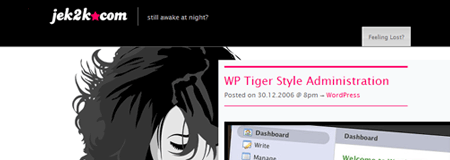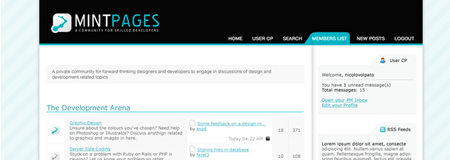Italy brings a lot more than some wonderful Italian food, because they also bring our friend Nicolò Volpato. An excellent designer and one of my favorites because of how classy he is, chats with us about his work and design in general in 2006.
Devlounge: Hello Nick, how’s it going? Thanks for taking some time off around the busy holiday season to answer some questions for me. It’s really an honor. Much like we begin most of our interviews, mind giving our readers the “411” on who you are?
Nicolò Volpato: Hello AJ, it is a pleasure for me to be interviewed here at Devlounge. My name is Nicolò Volpato. I’m 24 and live in Rimini, one of Italy’s most famous seaside resorts. I’m a full-time freelance web designer and Flash developer.
You probably got to know me because I recently designed the latest version of PhotoMatt and contributed to the MintPages forum skin. However I’ve been designing websites for the last 7 years. Since 2004, I also run my own design studio called GNV & Partners, based in my home-town Rimini.
In my spare time I play around with my blog at www.jek2k.com. Since 1999, Jek2k.com is my home on the Web, the place where I post personal stuff, photos, articles and my playground, where I can experiment with new technologies. It has always played a key role in my professional carrier and recently it’s been earning me a lot of visibility.

DL: How’d you get started with design and build up your skill set?
NV: I got my first 56k Internet connection back in 1998 (in Italy we’re always two steps back than the rest of the world…) and I started playing with creating websites some months later. In October 1999 I published the very first version of Jek2k.com.
It began as a way to spend my afternoons, but all of a sudden it became a passion. I bought books, I read hundreds of online tutorials and I devoted a huge amount of time to learn and improve my skills.
I started with plain HTML, but after some time it was not enough and I added CSS. Then I needed a bit of Javascript and ASP to spice things up. One thing lead to another, until I was able to create a complete website from A to Z.
The same happened with Flash. I started with Flash 4 and since the very beginning I’ve been interested in Flash ability to build rich and interactive interfaces. So I learned ActionScript. I had no programming background at that time, so it has been hard to dive into a completely new language and understand programming logics. Luckily, at 17, I had enough time and passion to make it.
This is how I learned all the technologies I use today.
Then in 2001 I chose a University that helped me to build an in-depth knowledge of both traditional and online communication, with a special focus on new media and the Internet as social environment. The importance of theory is often under-estimated in web design, but I think it is really a plus for a designer to have a psychology and communication background.
DL: Let’s talk about your blog, jek2k. As I type these interview questions, I’m reading
your latest post on hitting 100,000 visitors since version six of the site was released
in June. Congrats on that, it’s a great accomplishment, especially for a short period
of time. What inspired the design behind the blog and the sick [awesome] illustration?
NV: Well, I really can’t explain myself how much success Jek2k.com has had in the last six months. I designed this latest version of my site to start playing with WordPress themes and some Javascript effects. I searched for a clean and professional-looking theme to start. I chose the Hemingway theme because it offered me a clean structure to build my design on. I kept many elements of the original theme, but I skinned them my way with CSS.
Then I added the background vector illustration of my girlfriend, which I made back in 2003, and made the main content semi-transparent to smoothly reveal the background.
Finally, and I think this is the most significant change, I couldn’t stand those typical sidebar things, such as Archives and Categories. So I moved them into a collapsible Javascript-animated drop-down panel, where they’re still easily accessible while leaving the layout much cleaner.
That’s it. I think Jek2k.com has been one of the first blogs to display such a modified version of Hemingway and a drop-down panel. Nowadays I see lots of sites like that and it is no more an original idea as it was 9 months ago when I started designing it.
DL: Besides running your own blog, you have your own studio, GNV & Partners. It’s apparent in your extensive collection of work that 1) you like large headers and 2) your all about practicing clean and valid xhtml and css. What do you think of the movement to standards based design which really took flight in 2006?
NV: I’ve been interested in web standards since some years now. I switched to XHTML and CSS in 2003 and since then I try to build all of my sites using only valid code. Moreover I try to write semantic markup and use table-less layouts.
I believe web standards must be considered the ground where we designers can build our sites on. They should be part of every designer’s daily work. Finally, in the last year, web standards have become a real standard. I think the blogging phenomenon and the Web 2.0 played a key role.
Blogging has made creating a personal website extremely easy and CMS allow everyone to publish contents in an intuitive way. The majority of blogging and CMS applications are based on web standards and produce valid markup, so there is a huge amount of young designers and web enthusiasts who are making their first approach to web design using web standards-compliant tools. They have no transition to face, no work routines to change. As the number of blogs increases day by day, so increases the number of web standards-compliant websites.
“Here we are witnessing a deep separation between Designers 2.0, who master web standards and take usability into consideration, and the all others, who keep doing their stuff the old way.”
Moreover the Web 2.0 definitely turned the web into a social environment. Developing services for the people means developing with web standards and usability in mind. So developers focused on making intuitive and friendly UIs (see AJAX and the many JavaScript libraries to enhance use experience). Designers left Flash and heavy graphics for clean and readable layouts, using standards to deliver interoperable websites.
However the job is not fully accomplished unfortunately. I live in a country where web standards are still considered a plus and usability is often ignored. Here we are witnessing a deep separation between Designers 2.0, who master web standards and take usability into consideration, and the all others, who keep doing their stuff the old way.
DL: You were recently called upon to redesign arguably the third most significant site in the wordpress world besides wordpress.com and wordpress.org, that being Photomatt. In the recent Fadtastic interview you discussed how nerve-racking the process was, so we won’t get into that, but what kind of feeling did you get knowing your work would be enjoyed by the millions visiting Matt’s blog from their WordPress Dashboards?

NV: When I gave my final PSD design files to Matt I didn’t know he was going to release the new site that soon. I was a bit surprised when I saw my design on PhotoMatt the next day. I knew that thousands of people would see my design and I was quite nervous about that. Are they going to like the new design or hate it? I had already talked with Matt and I knew he liked the design, but I feared the people’s feedback. Luckily it was good. When I read the first good comments from users on his blog I relaxed a bit.
In the following days and weeks I’ve read many blog posts and articles about PhotoMatt’s redesign and that has been a great satisfaction.
DL: I also was lucky enough to witness your work pattern as I watched three mockups of Mintpages get refined each week based on user feedback. New designers always seem to struggle with taking and accepting feedback from others, because if a designs considered bad and gets hit with many disheartening comments it can take a new designer out of it. Mind explaining why it’s so vital to take feedback and build from it and not get frustrated?
NV: Well, I still haven’t found a way of not getting frustrated by negative comments. If you ever find one, give me a shout, because I need it too.
Apart from that, all we have to do as designers is to take every feedback in a constructive way. We shouldn’t get offended by a negative feedback and it doesn’t mean we are bad designers. It just means we can improve our design. After all, we learn from mistakes, don’t we? Frustration is just human, but we need to turn it into motivation. One thing that I think needs to be said: many times, especially in forums or in blog comments, feedbacks are given in a, let’s say, not-so-polite way. It’s easy to see comments like “I don’t like it at all”, “Your design sucks”, and even worse.
This kind of feedback is useless and for a young designer can be very hard to take. How can you make your design better basing on such a kind of feedback? Designing is finding the right balance between the designer’s ideas and the client’s needs, in a given context, with particular communications needs and peculiar problems and limitations. This should be kept in mind when giving a feedback, cause we don’t know how some design choices were made.
“While being confident about choices is good for a designer, feedback on execution can really help us doing our work better and focusing more on details.”
On the other hand designers should be open to feedback regarding execution: even the best design choice can be executed in a poor way. While being confident about choices is good for a designer, feedback on execution can really help us doing our work better and focusing more on details. This article deals with some interesting points for young designers and is a must-read in my opinion.
DL: What are some of your favorite resources, whether it be daily websites you read, books, design galleries, or music that inspires your design?
NV: I visit CSS galleries daily, CSS Remix is my favorite one. In general I don’t rely heavily on CSS galleries and design trends. They are an easy way to design a trendy website or to take inspiration, but they are also dangerous, because you risk to lose your originality and stick to a predefined style. This is a really interesting and provoking article on this topic.
I keep an eye on Solution Watch, Devlounge (of course), Jonathan Snook’s and Veerle’s blogs and Fadtastic, to see what’s going on in the web design scenario.

MintPages is a great place to exchange opinions and get feedback from other experienced designers and developers. I like browsing design, interior design and architecture books, to see how great designers and architects used space and shapes to build beautiful and useful objects or comfortable places. I like photography and art books to learn the use of colors and light to express emotions and feelings. I’d like to be able to do the same with websites.
DL: Your turn to share whatever you’d like. What do you like to do outside of designing?
NV: Hmmm….. designing? I spend pretty much all of my time in front of my Mac. This is for me much more than a job and love devoting hours and hours to browse websites and try new techniques in Photoshops or Flash. This is how I got to be what I am today.
Apart from that, I love spending time with my girlfriend, watching movies, playing around with my digital camera, doing the typical geek things (like configuring my LAN or disassembling some old PC hardware…) and collecting Star Wars toys.
DL: Out of all your work from 2006, what was your favorite project / design to be a part of?
NV: This is a tough question. I never really thought about this. I like to think that my best design is yet to come, this helps me finding motivation and struggle to always do my best.
To name a few, the MICE CD-Rom is the biggest project I’ve been involved in, in terms of time spent and people in the development team. PhotoMatt is with no doubt the most important project I’ve ever done and the one that earned me the most visibility. But the good old Jek2k.com is the site that gave me the biggest satisfactions in 2006 and without it there would have been no PhotoMatt, no MintPages and even not this interview.
DL: Once again, thanks for your time. It’s been a pleasure. I know I’m looking forward to seeing more of your work around the net in 2007 and beyond. Happy holidays and happy new year!
NV: Thank you for this opportunity. I wish a happy 2007 to you and all the Devlounge team. Keep up the good work!
Be sure to visit Jek2k to check out more of Nick’s work!

